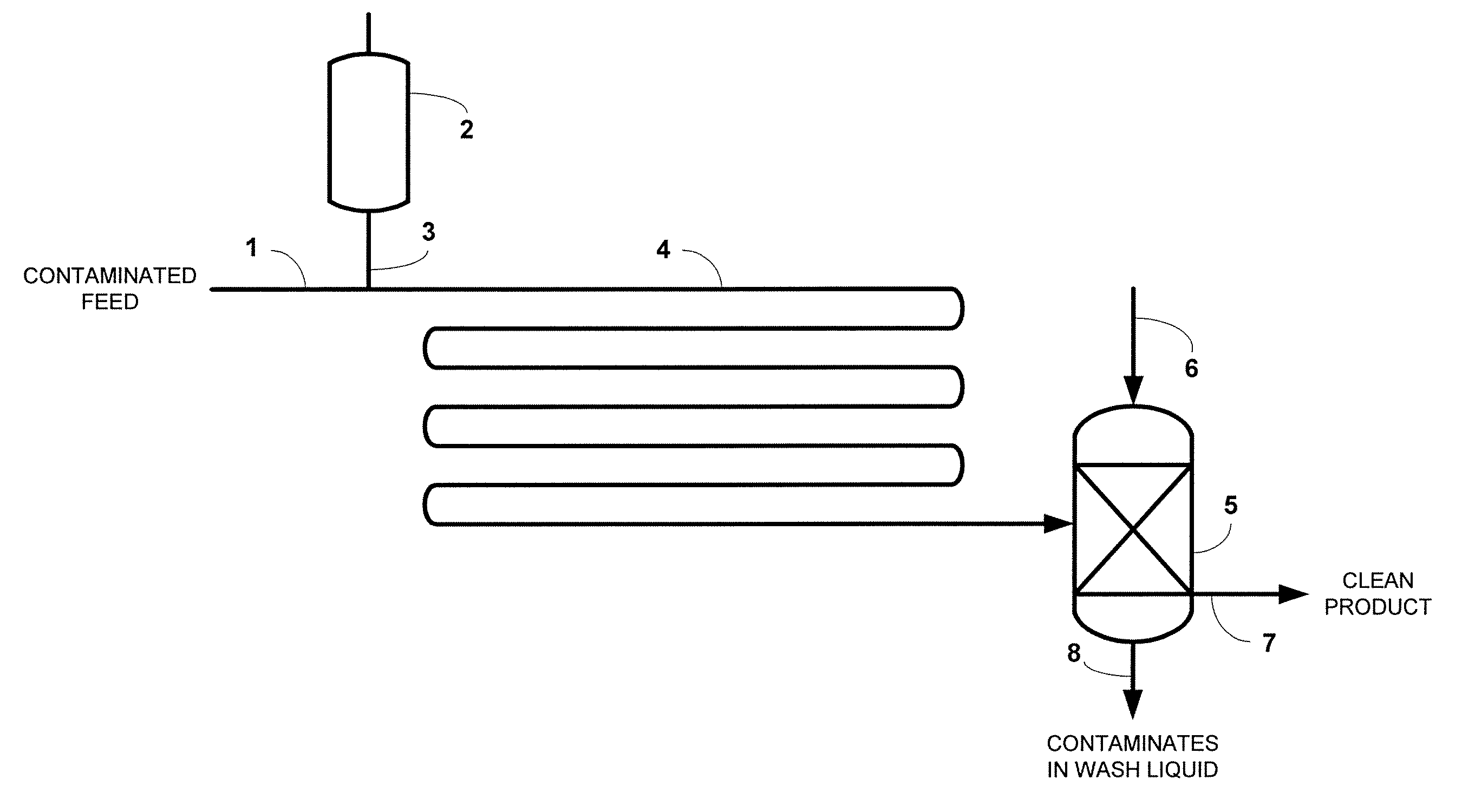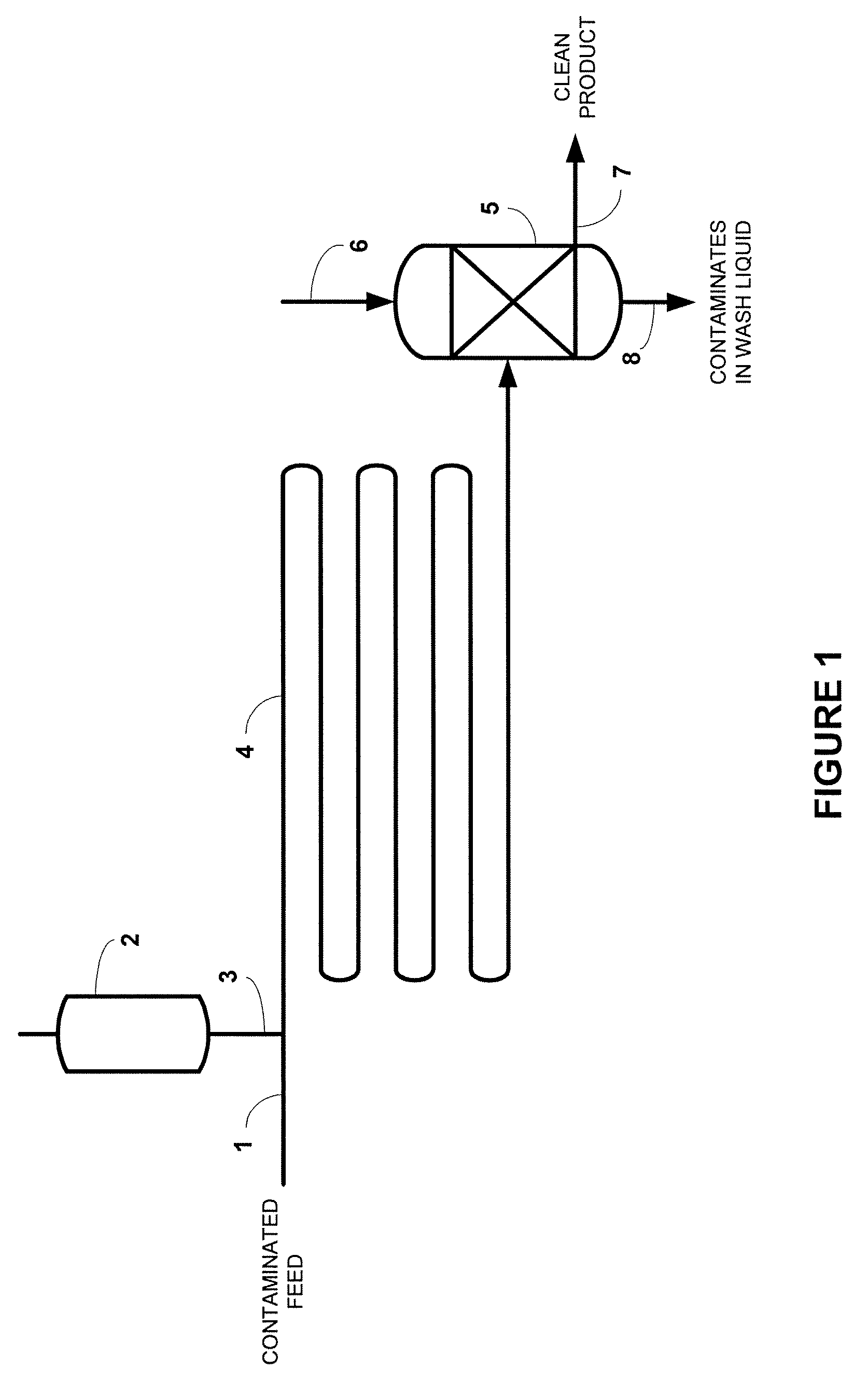Process for desulfurization of hydrocarbons
a hydrocarbon and desulfurization technology, applied in the direction of sulfur compounds, metal refining, non-metal raffination, etc., can solve the problems of inability to produce extremely small droplets, financial loss to the refiner,
- Summary
- Abstract
- Description
- Claims
- Application Information
AI Technical Summary
Benefits of technology
Problems solved by technology
Method used
Image
Examples
example 1
[0031]A feed comprising n-hexadecane (to simulate a diesel feed), dodecane (as an internal standard), dibenzothiophene (DBT) and 4, 6-dimethyldibenzothiophene (46 DBT) was prepared. The final sulfur content of the feed was ˜75 ppm with ˜50 ppm S contributed by DBT and ˜25 ppm S contributed by the 46 DBT. Approximately five grams of this feed were added to an Erlynmeyer flask along with a piece of freshly cut sodium weighing approximately 0.14 gram. The mixture was stirred magnetically at room temperature (approximately 25° C.) for 1 hour during which time it was noted that the sodium did not change shape or size. At the end of the run ˜25 ml of ethanol were added to consume the remaining sodium, the mixture was centrifuged to separate the phases, and the feed liquid was analyzed for DBT and 46 DBT. Gas chromatographic analysis showed 0% reduction of DBT and <5% reduction of 46 DBT. Therefore, treatment with sodium alone had little or no effect on the sulfur content of the feed.
example 2
[0032]Approximately five grams of the feed from Example 1 were added to an Erlynmeyer flask along with 5 grams of tetrahydrofuran (THF) which is known to have some solubility for sodium. Again a piece of sodium weighing approximately 0.09 grams was added and the mixture was stirred magnetically at room temperature (approximately 25° C.) for four hours (four times longer than in Example 1). At the end of the run ˜25 ml of ethanol were added to consume the remaining sodium, the mixture was centrifuged to separate the phases, and the feed liquid was analyzed for DBT and 46 DBT. Gas chromatographic analysis showed that the DBT concentration had been reduced by 42% and the 46 DBT by 12% indicating that the simple addition of THF to sodium had little effect on removal of sulfur from the feed.
example 3
[0033]Approximately five grams of the feed from Example 1 were added to an Erlynmeyer flask along with 5 grams of tetrahydrofuran (THF) which is known to have some solubility for sodium and 0.97 gram tetraazadodecane (a tetramine that was thought to have a slightly higher solubility for sodium than THF). Again a piece of sodium weighing approximately 0.08 grams was added and the mixture was stirred magnetically at room temperature (approximately 25° C.) for four hours (four times longer than in Example 1) during which time it was noted that the sodium did not change shape or size. At the end of the run ˜25 ml of ethanol were added to consume the remaining sodium, the mixture was centrifuged to separate the phases, and the feed liquid was analyzed for DBT and 46 DBT. Gas chromatographic analysis showed that the DBT concentration had been reduced by 78% and the 46 DBT by 53% indicating that the addition of the diamine aided somewhat in the reaction but still produced sulfur reduction ...
PUM
| Property | Measurement | Unit |
|---|---|---|
| melting point | aaaaa | aaaaa |
| temperatures | aaaaa | aaaaa |
| temperatures | aaaaa | aaaaa |
Abstract
Description
Claims
Application Information
 Login to View More
Login to View More - R&D
- Intellectual Property
- Life Sciences
- Materials
- Tech Scout
- Unparalleled Data Quality
- Higher Quality Content
- 60% Fewer Hallucinations
Browse by: Latest US Patents, China's latest patents, Technical Efficacy Thesaurus, Application Domain, Technology Topic, Popular Technical Reports.
© 2025 PatSnap. All rights reserved.Legal|Privacy policy|Modern Slavery Act Transparency Statement|Sitemap|About US| Contact US: help@patsnap.com



